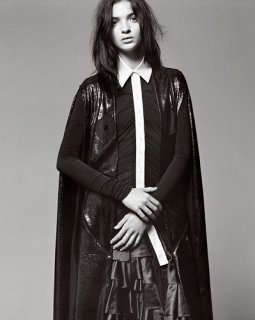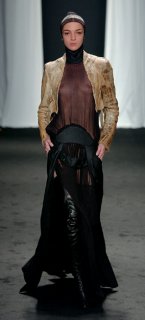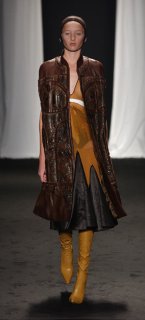Interview
Tisci's Triumph
Milan
In March of this year, Riccardo Tisci signed a three-year contract to helm the house of Ruffo Research. In May, the Italian leather house changed plans, forcing Tisci to act quickly, retreat to India and pull together his own collection that showed during Milan's fashion week. Top grade models including Karen Elson, Maria Carla Boscono and Liya Keyebe played sirens in Tisci's fantastic and moody world of sweeping, lightly embroidered dresses and dramatic tops — set against a backdrop of disused car parts and oversized black balls amid a smoky and mysterious air (an art directorial tour de force conjured up by friends Macs Iotti and Susanna Cucco of the Shelter Group). The event shook the shows last week, not for its over-the-top spending and glitzy presentation, but simply for its personal expression, organic production, and the reassurance that those fashion moments can still be experienced. Tisci discussed his fashion coup with Jason Campbell soon after his presentation.
JCR: What fascinated me about your show was the sheer joy of creative expression involved. Your friends rallied behind you and you pulled off one of the most stunning events during Milan fashion week, it was a fashion moment...
RT: As you know, I was supposed to be doing Ruffo Research. They then had a problem with the factory and stopped the collection that I was designing. For the first few days I was really lost because I had just signed a three-year contract with them just a few months earlier. So basically I found myself with nothing, but with the encouragement of friends, buyers and press, who said, you should do your own label, I said, OK fine, I'm going to India. I have friends with an embroidery company in India and I went and made a little capsule collection. Initially it was just a collection of ten pieces and while I was there I sent some pieces to friends who were very encouraging. They said, we know you don't have money, but you should do a presentation because the collection is really good. And basically all my friends worked for free. Macs [Iotti] and Susanna [Cucco] did the art direction, found me the location, and did the invitations. Maria Carla Boscono did the casting.
JCR: So that's how you were able to get those super pricey models to play theatre for your show?
RT: Maria Carla Boscono is my best friend, she's like a sister. I've known Liya for a few years and I know a few of the girls, but basically these girls heard of this young designer and they wanted to support me. They wanted to be in this project though they knew that I was not able to pay them. They said, we love your clothes and we're going to do this for free. And when four or five girls say they'll do it for free, all the other girls want to do it.
JCR: Karine Roitfeld's attendance didn't hurt?
RT: I was very shocked that Karine showed up, American Vogue, Another magazine, Dazed and Confused. It was Maria Carla who was chatting.
JCR: You went to India for a month to work on a collection that mixed a variety of dark elements including Victorian and ethnic, what gave you the confidence to go to India?
RT: When I finished school at St. Martins I had my own collection. After my graduation show, Kokon Tozai in London asked me to buy the collection, I didn't want to sell my graduation collection because there's only one you do, and I wanted to keep it as an archive. So they asked me to do a few pieces: a few dresses, t-shirts to sell in the shop. And they were really a hit, Lucinda Chambers {British Vogue} took some clothes and shot them, Bjork bought some pieces. Things went really well and for a few years and I had a Riccardo Tisci collection that was really homemade by my mom and sisters who sewed everything by hand. More press followed and I then I was offered several jobs. I was a creative director at Puma and also for Coccapani. And when you do these kinds of things, you have the confidence to do whatever else. How the aesthetic came about is that I've been collecting inspiring things, colors, etc for some time and I said to myself when I do the Riccardo Tisci line, this is where I'll go. When I decided that I would in fact do the line this summer, I took my little book of inspiration and brought it with me which allowed me to finish the collection in just a month, and it was very me.
JCR: All of this was very un-Milan in term of aesthetic, buzz, and presentation. Did it concern that you would get lost in the show shuffle in Milan?
RT: My background is 100% Italian even though I spent nine years in London studying and I am aware that my style is not very Milan. Also the way that we presented the show wasn't very Italian. Don't be mistaken, I love sexy and love a lot of things Italian. I'm a proud of my culture but there are other things I like as well. And I think that's why the show was such a big success, everyone was so shocked, they said it felt like a Paris.
JCR: Was this a big f*ck-you collection to Ruffo?
RT: This was just for myself. In a way, it wasn't their fault. It really became too complicated to send out a collection. They had a lot of labels to look after and they decided to re-launch Ruffo without planning properly. To make a collection with leather jersey, evening wear, to make a real collection, the timing was impossible.
JCR: Your contract is over then; it won't continue?
RT: I don't know what is going to happen but my contract is still on. For me though, in life, things happen for a reason. This Ruffo thing was in a way my wake up call, to say hello Ricki, probably you should be doing your own collection. I would have never found the courage to do it otherwise.
JCR: In this age of carefully strategize brand building what are the plans for your brand?
RT: At the moment, I really want to express myself. I want keep doing these small collections like this one that has only 60 pieces. For Coccopani and Puma for example, there were 200 pieces, I prefer small. And I want to be placed in the right shops.
JCR: You're selling this season?
RT: Yes, I'm in Paris this week selling the collection myself.
JCR: And where do you want to sell?
RT: Like the dream of young designers, I want to sell in all the top shops in the world. I want to be in Los Angeles, New York, London, Paris, in the big fashion capitols, in the cool shops.
JCR: There's already buzz about your candidacy for the Givenchy post. Are you looking for another house to helm?
RT: I was just telling my agent today that if there's something that comes up and I feel that I really want to do, then I'll do that. I don't want to do things I don't like to do anymore. Now, I will look after myself and wait for the chance of my life.
JCR: And the Givenchy post is something that would interest you?
RT: Of course, Givenchy is a big label, it's French, and it has history. I definitely want to do a label with a history. When you do the in between, at medium sized companies, they don't necessarily have the complete team, the right pattern cutter, the right merchandiser. It's not just about fashion — it's about the making, the quality, the marketing, everything.












